Shrubs or small trees, to 7 m tall; bark gray. Branchlets pubescent and stipitate glandular, with white lenticels. Petiole slender, 1-2(-3) cm, sparsely pubescent; leaf blade oblong, elliptic, elliptic-obovate, broadly ovate, or obovate to suborbicular, 4-13 × 2.5-10 cm, papery, abaxially pilose along veins, adaxially glabrous, base cordate, margin irregularly and doubly serrate, usually lobed, apex mucronate to caudate; lateral veins 3-7 on each side of midvein. Male inflorescences 2-5 in a cluster, pendulous, slender, ca. 4 cm; bracts reddish brown, obovate, densely pubescent, apex acuminate from nearly truncate, apical portion of leaf. Female flowers 2-6 in a cluster; bracts campanulate, 1.5-2.5 cm, striate, densely pubescent and stipitate glandular near base, with triangular-ovate, entire or dentate lobes. Nut ovoid-globose, ca. as long as bracts, 0.7-1.5 cm in diam., apex villous. Fl. May-Jul, fr. Jul-Aug. 2n = 22.
More
A shrub or small tree. It grows 6 m tall. The leaves are rounded and come to an abrupt point. There are teeth along the edge. They are covered with fine hairs. The leaves are downy underneath. The flowers are in catkins which develop into single or paired fruit. The fruit are enclosed in leafy bracts. The nuts have a hard shell.
Warm light slopes, growing in open forests, along forest edges, on scree slopes, on hills that have been subject to deforestation, in dry river valleys, and in vast thickets on mountain slopes; at elevations up to 2,770 metres.
More
It is a temperate plant. It grows in temperate broad-leaved forests, thickets on mountain slopes between 400–2500 m altitude in China. It suits hardiness zones 6-9.
Can be grown by seedlings. Seeds needs soaking.


